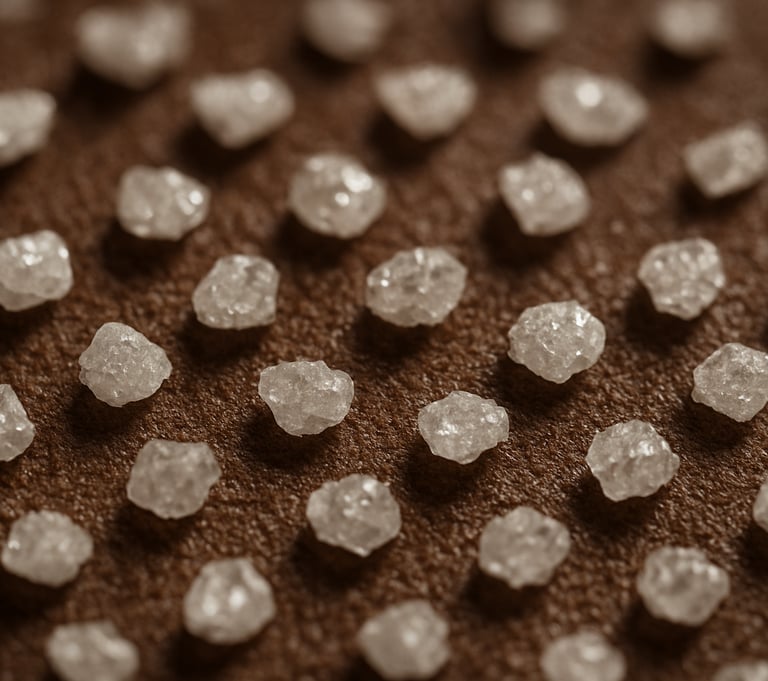The Role of White Fused Alumina in Sandpaper Manufacturing
White fused alumina (WFA) is a dominant abrasive in sandpaper production thanks to its high hardness, thermal stability and chemical purity. This article explains WFA properties, common grit ranges for sandpaper, coating/bonding methods, quality control considerations, and practical selection advice for different sanding applications.
XINLI ABRASIVE
10/16/20253 min read


1. What is White Fused Alumina?
White fused alumina (WFA) — also called white fused aluminum oxide — is an industrial abrasive produced by melting high-purity alumina in an electric arc furnace and cooling it into crystalline grains. WFA is characterized by high Al₂O₃ content (commonly ≥99%), sharp cutting edges, and good thermal and chemical stability.
Why it matters for sandpaper: WFA’s hardness and toughness provide efficient material removal and long life while minimizing contamination and staining — crucial for finishing wood, paint, metal, and composite surfaces.
2. Key Physical & Chemical Properties (short)
Composition: Mostly α-Al₂O₃ (alumina), high purity.
Hardness: Mohs ~9 (very hard).
Morphology: Angular-to-subangular grains with sharp edges (good cutting action).
Thermal stability: High — resists breakdown under heat from sanding.
Chemical inertness: Low reactivity — won’t easily react with binders/pigments.
3. Role in Sandpaper Manufacturing — Process Overview
3.1 Grain selection & classification
Manufacturers grade WFA into particle-size ranges (often expressed as F-numbers or micron D50). For sandpaper, common groupings are:
Coarse (heavy removal): F24–F60 (larger grains, fast stock removal; used for aggressive sanding and paint/varnish removal)
Medium (general purpose): F80–F180 (surface leveling, preparatory sanding)
Fine (finishing): F220–F800 (smoothing and final prep before finishing)
Micro/Polishing: F1000+ / submicron powders (specialized polishing papers and films)
Note: In many industries, WFA F-numbers map to standard P-grit designations (P24, P80, P220, etc.). Always confirm supplier particle sizing (D10/D50/D90) rather than relying solely on nominal F numbers.
3.2 Coating & bonding methods
Sandpaper combines abrasive grains with a backing (paper, cloth, film) via a bonding system:
Resin bonds (phenolic, urea formaldehyde): High heat/pressure resistance; used for heavy-duty papers.
Glue bonds (animal/vegetable or synthetic adhesives): Lower cost, used for general-purpose papers.
Electrostatic coating: Grains oriented to edge (better bite) using electrostatic field during coating. Common for open-coated sanding belts and sheets.
Stearate or anti-loading topcoats: Added to reduce clogging when sanding resinous materials.
WFA is compatible with common bond systems due to its chemical stability and inert surface.
3.3 Grain shape and surface finish
The angular shape of fused alumina provides aggressive cutting action. Controlled micron-level polishing is achievable by selecting finer WFA grades or spheroidized/rounded WFA for less aggressive finishing.
4. Performance Benefits of WFA in Sandpaper
Longer life: High hardness and toughness resist fracture and glazing.
Stable cutting: Sharp edges maintain cutting ability longer than many natural abrasives.
Low contamination: High purity reduces staining on light-colored substrates (important for wood finishing).
Thermal resistance: Handles heat generated during high-speed sanding.
Versatility: Works on wood, metal, composites, plastics, and paint systems.
5. How to Choose WFA for Specific Sanding Needs
For woodworking:
Rough removal: F36–F60 (coarse WFA).
Smoothing: F120–F220.
Final sanding before finish: F240–F400 (or micro-alumina powders for ultra-fine finishes).
For metalwork:
Deburring & blending: F80–F180.
Finish polishing: F400–F800 (or use alumina oxide polishing compounds in slurry).
For paint/auto body:
Paint stripping: F24–F40 (robust, fast removal).
Preparing for primer: F80–F180 (consistent surface for adhesion).
For specialty coated papers (industrial / optical films):
Use ultra-fine and high-purity WFA powders to minimize particle fallout and contamination.
6. Quality Control: What Buyers Should Check
When sourcing WFA for sandpaper production, require the following data from suppliers:
Chemical purity (Al₂O₃ %) — higher is better for contamination-sensitive applications.
Particle size distribution (D10/D50/D90) — ensures consistency across batches.
Morphology images (SEM) — confirms grain shape and expected cutting behavior.
Impurity analysis (Fe, Na, etc.) — critical for wood finishing & paint color integrity.
Bulk density and flow characteristics — influences coating performance.
Moisture content & storage stability.
7. Common Problems & Solutions
Glazing: Abrasive grains smear or sinter under heat — choose higher-grade WFA or change bonding system to reduce heat.
Clogging (loading): Use stearated abrasives or open-coating; optimize grain size for material.
Uneven cut / chatter: Check grain distribution (D90/D10 spread), backing stiffness, and bonding uniformity.
Color contamination: Source ultra-pure WFA and insist on low iron content for light wood/paint work.
8. Practical Tips for Manufacturers
Insist on batch certificates with particle distribution and impurity tests.
Test candidate WFA in real coating trials (small pilot runs) — lab specs don’t always predict real-world performance.
Consider electrostatic coating if you need higher bite and more consistent grain orientation.
For high-value finishing papers, prefer narrower PSD (particle size distribution) and finer D50 control.
9. Conclusion
White fused alumina is a versatile, high-performance abrasive widely used in sandpaper manufacturing. Proper grade selection (grit), bonding method, and QC can dramatically impact sandpaper lifetime and finish quality. For manufacturers and procurement teams, focusing on particle distribution and purity will yield the best performance across wood, metal, and specialty finishing applications.


